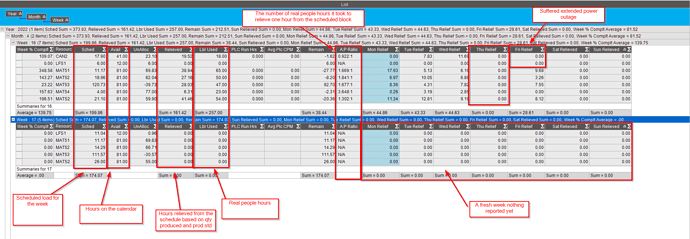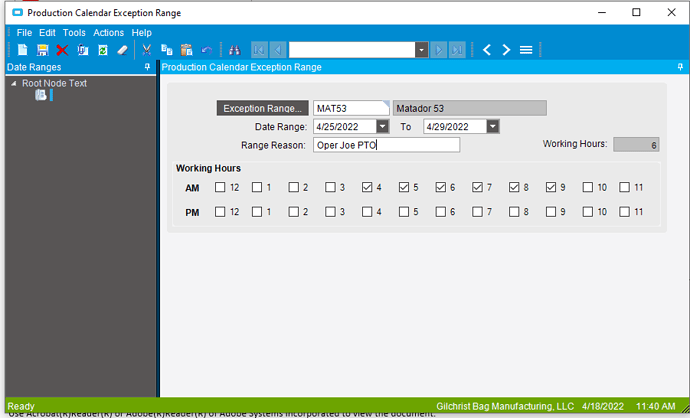We’ve been using E9 for 12 years now and are currently moving up to E11. We are a small (<50) shop making custom conveyors. In E9 we have resource groups and resources setup but we don’t use scheduling. We want to use scheduling in E11 but management wants to set resources by people in some departments. Our assembly department is all workforce (no machines) and has about 9 workers in it. This number can change daily as people have sick, vacations, call-offs, quit, temps come and go.
Management wanted to set a production calendar for the total available hours but that won’t work. Their reasoning is “We have 10 workers this week, 8 hours per day times 80% efficient equals 350 hours available this week.” Production calendars only go to 24 hours. Then they wanted to add the employees as crew sizes on the resource group and have me adjust that number daily as the number of employees fluctuate. I balked at the idea of adjusting a setup screen daily.
Scheduling our machines is easy, 1 machine equals 1 resource, but it seems like Epicor doesn’t handle a human workforce very well.
What’s everyone else doing for this type of scheduling?
Average the number of hours you are getting a week and set your calendars for that. Trying to manage employees as resources is a rabbit hole many have abandoned. Example our machine 102 is effective available 24/7 but with people that is obviously not the case. On an average week taking into account vacations, sick days, etc we get 123 hours of labor. We take that 123 and spread our production calendar across a week for that many hours. Make sense?
Thanks for your reply. I see where you are going but I’m not sure how to get the numbers. We average 9 people in Assembly and even at 5 hours per day efficiency thats 40 hours but our production calendar only goes up to 24 hours per day. I’m not sure where to put the numbers in.
I’m researching trying to add the average number of workers as resources and tie them to the resource group. It looks clumsy and probably complicated. I’m not sure how others do it.
Thanks again.
You evaluate how many hours are relieved from your schedule on average and plan your calendar for that. The number of people comes from crew size and is a matter of costing only. We created a dashboard for ourselves to track shop load planned for a week compared to how many hours were reported compared to how many hours were relieved from that load. Example
On sunday we noted that we had 87 hours on the schedule for this 102 machine.
Over the course of the week we recorded 165 man hours (multiple people clocked in on jobs for that machine)
We didn’t hit production standard for those man hours and only relieved 60 hours from our schedule.
That means for the current week we worked at effectively 33%ish to standard (horrible) and are now behind 27 schedule hours that will carry into next week we have to play catch up on.
Make sense?
That is very intriguing. I like where your going with it. So you count this resource group as only having 1 resource and just work toward the number of hours needed (load) vs the hours relieved? That sound much less complicated.
I would love to see your dashboard and query someday, without any company sensitive stuff of course, I would like to try building one for us even if just for internal sanity checking.
Thanks alot!
The daily capacity of a resource group is equal to the number of active resources in the resource group X the number of working hours in the calendar. Maybe you can play with the number of active resources vs the calendar to get your number ?
As @jgiese.wci said, crew size has no impact on scheduling, it is used for costing.
And then you will probably say that on some occasions more than one person works at the same time on the same job, so someone will suggest to look at scheduling blocks… You will try to read the documentation and run some tests… and a couple weeks later you will try to persuade management to throw Epicor in the trash and switch ERP software. Classic.
EDIT : Sorry for the rant. Here’s a post if you want my opinion on the matter:
@rturrentine We have 175 people on the floor and have been doing this since 2012 with generic team members. EG. CORE01 - CORE01TM01, CORE01TM02. We have a shop calendar with 8 hours per day. We factor in attendance and efficiency and then set the approximate team members active in their resource group. We currently have 17 resource groups active. We adjust weekly, but capacity is for planning and is different than labor usage.
One thing to watch out for is an inactive resource will still be counted as possible hours by Epicor so they need to be moved to another inactive resource group IE CORE00. There is a move button, but I made an updateable baq to move them which you ae welcome to.
We also use these resources as scheduling blocks or machines to apply what Epicor calls the squeeze factor for scheduling jobs.
A 2 week view. I included this week even though there is no report yet as the idea is come tuesday we are already assessing how far behind we are from monday troubles.
Very nice DB @jgiese.wci - I may try and reproduce some of that for us as well.
We don’t look at it as relieved, but rather just look at the remaining hours on the operations as 99% of our OPs are one operator. I like this layout, and the ratio column is a nice indicator.
Wicked dashboard Joshua.
We can filter the dashboard by resource and look to see if we have a machine trending week over week ahead or behind using that ratio and adjust production calendars or maintenance needs. If we are unable to meet or beat the time we use the ratio to adjust the calendar either with exceptions if we deem the issue temporary or as a whole for an undetermined amount of time. Best example
Machine X runs on 2 shifts for a total of 60 hours a week (nominally) we have someone out for a week on second. Our capacity is really now 30 hours. I built a UD screen that will take a range and a set number of hours and add calendar exceptions for that range. We limit the hours to 30 for a range of a week, the schedule adjusts accordingly, when that person returns we pick up as normal. If we have a call-in we don’t do anything with that, it is what it is, but the dashboard will show us if that call-in hurt us the next day or even by the afternoon of the same day really.
Exception range. Adds on the MAT53 resource calendar exceptions on every day for 4/25 - 4/29 limiting hours to 6 effective hours a day.
That is sweet! We may need to chat a bit more at Insights 
Pretty incredible.

